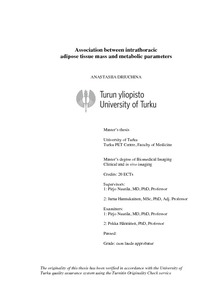Association between intrathoracic adipose tissue mass and metabolic parameters
Driuchina, Anastasiia (2018-05-30)
Association between intrathoracic adipose tissue mass and metabolic parameters
Driuchina, Anastasiia
(30.05.2018)
Turun yliopisto
avoin
Julkaisun pysyvä osoite on:
https://urn.fi/URN:NBN:fi-fe2018053024998
https://urn.fi/URN:NBN:fi-fe2018053024998
Tiivistelmä
Overweight or obesity, along with type 2 diabetes mellitus, is one of the major causes of cardiovascular morbidity and mortality. In the heart, fat is deposited inside – myocardial triglyceride content, and outside the myocardium, so called intrathoracic fat which is divided by pericardium to epicardial and pericardial adipose tissue.
The aim of this project was to establish the association between intrathoracic adipose tissue distribution and metabolic profile of patients with type 2 diabetes mellitus.
The study group consisted of 31 patients (78 % male, mean age 62 ± 8, mean BMI 32 kg/m2) with type 2 diabetes mellitus. Magnetic resonance imaging was used to assess cardiac fat volumes. Additional laboratory and anthropometric measurements were performed.
The study showed that men tend to have higher cardiac adipose tissue mass than women (epicardial 263 and 234 g, p = .168; pericardial 272 and 176 g, p = .013; intrathoracic 535 and 410 g, p = .018). Subjects with larger waist circumference (more than 102 cm in men, and more than 88 cm in women) showed higher cardiac adipose tissue mass than subjects with smaller waist circumference; however, there were no statistically significant differences (epicardial 261 and 240 g; pericardial 251 and 243 g). There was a positive correlation between cardiac fat mass and waist circumference (epicardial rs = .398, p = .027; intrathoracic rs = .378, p = .036).
Study results showed that cardiac fat mass measurement by MRI might provide important information about the metabolic and cardiovascular risk. In the future, it would be interesting to investigate the association between cardiac fat depots and the amount of visceral adipose tissue along with lipid profile.
The aim of this project was to establish the association between intrathoracic adipose tissue distribution and metabolic profile of patients with type 2 diabetes mellitus.
The study group consisted of 31 patients (78 % male, mean age 62 ± 8, mean BMI 32 kg/m2) with type 2 diabetes mellitus. Magnetic resonance imaging was used to assess cardiac fat volumes. Additional laboratory and anthropometric measurements were performed.
The study showed that men tend to have higher cardiac adipose tissue mass than women (epicardial 263 and 234 g, p = .168; pericardial 272 and 176 g, p = .013; intrathoracic 535 and 410 g, p = .018). Subjects with larger waist circumference (more than 102 cm in men, and more than 88 cm in women) showed higher cardiac adipose tissue mass than subjects with smaller waist circumference; however, there were no statistically significant differences (epicardial 261 and 240 g; pericardial 251 and 243 g). There was a positive correlation between cardiac fat mass and waist circumference (epicardial rs = .398, p = .027; intrathoracic rs = .378, p = .036).
Study results showed that cardiac fat mass measurement by MRI might provide important information about the metabolic and cardiovascular risk. In the future, it would be interesting to investigate the association between cardiac fat depots and the amount of visceral adipose tissue along with lipid profile.
